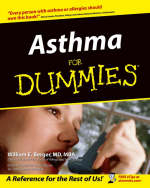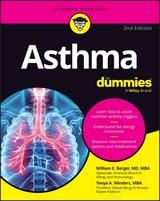
Asthma For Dummies
For Dummies (Verlag)
978-0-7645-4233-6 (ISBN)
- Titel erscheint in neuer Auflage
- Artikel merken
The incidence of asthma is rising dramatically in the United States and across the globe. Asthma affects 17 million people in the U.S. and is the most common chronic childhood disease. If you or someone you love suffers from asthma, you know that there is no cure—however, with proper care, asthmatics can lead normal, active, and fulfilling lives. Now you can breathe easy with this plain-English guide, which clearly explains the prevention, diagnosis, symptoms, and treatment of the disease. Asthma For Dummies will help asthma sufferers and their loved ones get a strong handle on managing the disease. Dr. William Berger, one of the nation’s foremost experts on allergies and asthma, gives you the tools you need to:
Understand the relationship between allergies and asthma
Identify your asthma triggers
Prepare for your first doctor’s visit
Allergy-proof your home or office environment
Avoid asthma complications
Find outside support
Featuring up-to-date coverage of childhood asthma, this easy-to-understand guide covers all the vital issues surrounding asthma, including handling food allergies, exercising when asthmatic, asthma during pregnancy, and all the latest medications. You’ll find tips on avoiding allergens that cause respiratory symptoms, testing for allergies, and dealing with HMOs. This fact-packed guide also features:
A dedicated chapter to asthma in the elderly
The latest information on Claritin and Clarinex, two common allergy medications taken by those with asthma
The interrelationships between asthma and other respiratory complications of untreated allergy such as ear, sinus, tonsil, and adenoid disease
Extensive information on controller drugs and rescue medications
Future trends in asthma therapy
Offering the latest on allergy shots and tips for traveling with asthma, Asthma for Dummies will relieve your anxiety about asthma, help you control your triggers, and manage the disease long-term.
William E. Berger, MD, MBA, has been diagnosing and treating patients with allergies and asthma for over 25 years and has served as president of the American College of Allergy, Asthma, and Immunology.
Foreword xxi
Introduction 1
About This Book 1
Foolish Assumptions 2
How This Book Is Organized 2
Part I: Asthma Basics 3
Part II: Understanding Asthma Triggers 3
Part III: Treating Your Asthma 3
Part IV: Controlling Asthma with Medications 3
Part V: Special Asthma Conditions 4
Part VI: The Part of Tens 4
Appendix 4
Icons Used in This Book 4
Where to Go from Here 5
Part I: Asthma Basics 7
Chapter 1: Knowing What’s Ailing You 9
Understanding the Relationship between Asthma and Allergies 10
Triggering Asthma and Allergic Reactions 13
Sensitizing your immune system 13
Developing an allergic reaction 13
Previewing Asthma and Related Conditions 15
Asthma: Breathing and wheezing 15
Allergic rhinitis: Running away with your nose 16
Atopic dermatitis: Scratching your itch 17
Food hypersensitivities: Serving up allergens 17
Drug hypersensitivities: Taking the wrong medicine 18
Anaphylaxis: Severe systemic symptoms 19
Managing Asthma Effectively 20
Chapter 2: The Basics of Treating and Managing Your Asthma 23
Understanding Who Gets Asthma and Why 23
Identifying triggers, attacks, episodes, and symptoms 25
Realizing that asthma isn’t in your head 25
Uncovering the Many Facets of Asthma 26
Allergic asthma 27
Non allergic asthma 27
Occupational asthma 28
Exercise-induced asthma (EIA) 28
Aspirin-induced (and food-additive-induced) asthma 28
Asthma and Your Airways 28
The inflammatory response 29
How airway obstruction develops 30
Diagnosing Asthma 32
Taking your medical history 32
Examining your condition 34
Testing your lungs 34
Considering other possible diagnoses 37
Classifying asthma severity 38
Referring to a specialist for diagnosis 38
Managing Your Asthma: Essential Steps 39
Going over the basics 39
Determining your asthma therapy goals 40
Handling emergencies 41
Managing asthma at school 42
Chapter 3: Dealing with Doctor Visits 43
Preparing for Your First Visit 44
Doing your homework 44
Filling out forms ahead of time 46
Telling your story 46
Recording your symptoms and medications 48
Focusing on foods 49
Taking your family history 49
Knowing What Tests Your Doctor May Perform 49
Looking for signs of asthma and allergies 50
Testing for asthma and allergies 50
Following Up: Second and Subsequent Visits 53
Getting a diagnosis: What happens next? 53
Considering allergy shots 54
Paying for Your Care 54
Dealing with insurance issues 55
Gatekeeping and your treatment 55
Getting the care you need and deserve 56
Working Well with Your Doctor 56
Chapter 4: Managing Asthma Long-Term 57
Seeing What a Long-Term Management Plan Includes 57
Focusing on the Four Levels of Asthma Severity 59
Using the Stepwise Approach 60
Stepping down 63
Stepping up 63
Treating severe episodes in stepwise management 64
Assessing Your Lungs 64
What your doctor should do: Spirometry 65
What you can do: Peak-flow monitoring 65
Taking Stock of Your Condition 68
Keeping symptom records 69
Tracking serious symptoms 69
Monitoring your medication use 70
Evaluating your inhaler technique 70
Understanding Self-Management 71
Working with your doctor 71
Evaluating for the long term 72
Becoming an expert about your asthma 72
Improving Your Quality of Life 73
Expecting the Best 73
Part II: Understanding Asthma Triggers 75
Chapter 5: Knowing Your Asthma Triggers 77
Recognizing What Triggers Your Asthma 78
Evaluating triggers 78
Testing for allergic triggers 80
Controlling Inhalant Allergens 81
Clearing the Air at Home 82
Household irritants 83
No smoking, please 83
Filters and air-cleaning devices 83
Working Out Workplace Exposures 84
Targeting workplace triggers 85
Diagnosing and treating workplace triggers 85
Avoiding Drug and Food Triggers 87
Aspirin sensitivities 87
Beta-blockers 88
Sensitivities to sulfites and other additives 88
Food allergies 89
Other Medical Conditions and Asthma 89
Rhinitis and sinusitis 89
Gastroesophageal reflux disease (GERD) 90
Viral infections 91
Chapter 6: Understanding Asthma and the Role of Allergies 93
Protecting Your Health: How Your Immune System Works 94
Classifying Immune System Components and Disorders 95
Protecting and serving in many ways 98
Distinguishing between immune deficiencies and allergic conditions 99
Immunizing and immunology 100
Classifying Abnormal Immune Responses 101
IgE-mediated reactions (Type I) 101
Cytotoxic reactions (Type II) 101
Immune complex reactions (Type III) 102
Cell-mediated reactions (Type IV) 102
Developing an Immediate Hypersensitivity 102
Setting the stage for allergic reactions 102
Reacting to allergen exposures 104
Doing it one more time: The late-phase reaction 106
Becoming hyperresponsive 106
Reacting nonspecifically 107
Reaping the Benefits of Immunology 107
Chapter 7: Hay Fever and Asthma: The United Airway 109
Catching Up with Your Runny Nose 110
Classifying Types of Hay Fever 112
Seasonal allergic rhinitis 113
Perennial allergic rhinitis 113
Occupational allergic rhinitis 114
What Makes Noses Run? 115
Getting a Medical Evaluation 115
Understanding that sneezy, itchy, and runny feeling 115
Seeing red: Allergic conjunctivitis 116
All that drips isn’t allergic 117
Knowing what the doctor’s looking for 119
Doing your part 120
Managing Rhinitis 121
Avoiding allergens 121
Treating with medications 121
Treating the cause of your allergies 122
Considering special cases 122
Chapter 8: Food Allergies and Asthma 125
Types of Adverse Food Reactions 126
Allergic Food Hypersensitivities 127
How allergic food hypersensitivities develop 129
Gastrointestinal tract allergies 129
Hives and other food-related skin reactions 130
Anaphylaxis and allergic food reactions 131
Non allergic (Non-IgE) Food Hypersensitivities 134
Understanding the Differences between Food Allergy and Food Intolerance 135
Lactose intolerance 135
Metabolic food reactions 135
Pharmacologic food reactions 136
Food additive reactions 136
Food poisoning 137
Diagnosing Adverse Food Reactions 137
Keeping a food diary 138
Considering atopic causes 138
Eliminating possible food culprits 138
Testing for food allergens 139
Avoiding Adverse Food Reactions 140
Chapter 9: Asthma and Exercise 141
Understanding EIA 141
Keeping Fit Despite EIA 142
Diagnosing EIA 142
Controlling EIA with medications 143
Athletes and EIA 143
Breathing competitively: Nose versus mouth 143
Warming up and cooling down to prevent EIA 144
Part III: Treating Your Asthma 145
Chapter 10: Avoiding Allergens That Cause
Respiratory Symptoms 147
Pollens 148
Pollen particulars 148
Counting your pollens 150
Allergens in the grass 153
Wheezy weeds 153
Can’t sneeze the forest for the trees 154
Molds 155
Spreading spores 155
Moldy matters 156
House Dust 156
Dust mites 157
What else is in my house dust? 158
Dust gets in your eyes or nose, throat, and lungs 158
Avoidance and Allergy-Proofing 159
Why avoidance matters 159
Knowing your limits 161
Crossing the line 161
Table of Contents xv
The Great Indoors 162
Indoor air pollution: Every breath you take can hurt you 162
Allergens on the barbie? 163
Allergy-Proofing Begins at Home 163
Controlling the dust in your house 164
Ridding your house of dust mites 165
Controlling dust mites in the bedroom 165
Regulating pet dander 166
Controlling mold in your abode 167
Pollen-proofing 168
Chapter 11: Getting Allergy Tested and Allergy Shots 171
Diagnosing with Skin Tests 172
Pins and needles 172
Skin tests and antihistamines: Not a good mix 173
Starting from scratch: Prick-puncture procedures 174
Getting under your skin: Intracutaneous testing 175
Skin test side effects 176
Blood testing for allergies 176
Reviewing Immunotherapy 177
Seeing how immunotherapy works 177
Deciding whether immunotherapy makes sense for you 178
Getting shots 179
Considering side effects 182
Looking at Future Forms of Immunotherapy 182
Chapter 12: Relieving Your Nasal Allergies 185
Getting Familiar with Pharmacology 186
Blocking Your Histamines: Antihistamines 187
Histamine hints 187
A dose of prevention 188
First-generation OTC antihistamines 188
Newer antihistamines 190
Antihistamines and children 194
Antihistamine nasal sprays 194
Decongesting Your Nose 195
Oral decongestants 195
Nasal decongestants 196
Two for the Nose: Combination Products 197
Analyzing the upside and downside 198
One size fits all may not suit your condition 199
Using Nasal Corticosteroids 199
Cromolyn Sodium 202
Reducing Mucus with Anticholinergic Sprays 203
Treating Rhinitis with Leukotriene Modifiers 204
Keeping an Eye out for Allergic Conjunctivitis 204
Chapter 13: Treating Your Ear, Nose, and Throat Symptoms 207
Complicating Your Allergies and Asthma: Sinusitis 208
Recognizing common causes 208
Sinus science 209
Practical sinus 210
How long has this been goin’ on? 211
Diagnosing sinusitis 212
Determining the best course of treatment 213
An ounce of prevention 215
Otitis Media 216
Revealing common causes 216
Getting an earful 217
Acute otitis media (AOM) 219
Otitis media with effusion (OME) 220
Diagnosing ear infections 221
Taking preventive measures 221
Part IV: Controlling Asthma with Medications 223
Chapter 14: Knowing Asthma Medications 225
Taking Your Medicine: Why It’s Essential 227
Looking at asthma’s changing dynamics 227
Tracking your asthma condition 227
Getting the Long and Short of Asthma Medications 229
Controlling asthma with long-term medications 230
Relieving asthma episodes with quick-relief products 231
Taking asthma medications prior to surgery 232
Delivering Your Dose: Inhalers and Nebulizers 233
Using a metered-dose inhaler 234
Using holding chambers 236
Using a dry-powder inhaler 236
Using a multidose-powder inhaler 239
Using nebulizers 240
Cleaning your medication delivery system 242
Chapter 15: Looking at Asthma Controller Drugs 243
Controlling Airway Inflammation with Corticosteroids 244
Inhaled corticosteroids 244
Oral corticosteroids 248
Preventing Respiratory Symptoms with Mast Cell Stabilizers 250
Cromolyn 251
Nedocromil 251
Prepping for mast cell stabilizers with other drugs 252
Knowing when mast cell stabilizers may not be enough 252
Dilating Your Airways with Long-Acting Bronchodilators 253
Combining two drugs: Advair 254
Understanding timing: Why long-acting products may not always be enough 254
Enhancing anti-inflammatory effectiveness 255
Relieving Nighttime Asthma with Theophylline 255
Watching out for theophylline’s undesirable side effects 256
Bad combinations: Adverse interactions with theophylline 257
Reducing Respiratory Symptoms with Leukotriene Modifiers 257
Understanding the importance of leukotrienes in asthma 259
Watching out for adverse side effects 259
Introducing the Newest Therapy on the Block: IgE Blocker 260
Chapter 16: Treating Asthma Episodes 263
Relieving Symptoms with Short-Acting Bronchodilators 264
Using short-acting bronchodilators effectively 268
Avoiding potential adverse side effects of short-acting bronchodilators 269
Introducing new and improved bronchodilation 270
Reversing Airflow Obstruction with Anticholinergics 272
Looking at Short-Term, Rescue Use of Oral Corticosteroids 273
Chapter 17: Future Trends in Asthma Therapy 275
Getting Better All the Time 276
Improving inhaled corticosteroids 276
Combining for complementary effect 276
Special delivery: More effective devices 277
Under Your Tongue: Swallow Immunotherapy 278
Blocking IgE: A Biotech Breakthrough 279
Exploring the Frontiers of Asthma Therapy 280
Inhibiting interleukins 280
Toll-like receptors (TLRs) 281
Gene therapy 282
Keeping Research Alive: Clinical Trials and You 282
Part V: Special Asthma Conditions 285
Chapter 18: Asthma during Childhood 287
Understanding Your Child’s Asthma 288
Inheriting asthma 289
Identifying children’s asthma triggers 289
Controlling — not outgrowing — asthma 290
Treating early to avoid problems later 290
Identifying Childhood-Onset Asthma 290
Taking your child’s medical history 291
Examining your child for signs of asthma 292
Testing your child’s lungs 292
All That Wheezes Isn’t Asthma 293
Focusing on Special Issues Concerning Childhood Asthma 293
Teaming up for the best treatment 295
Managing asthma in infants (newborns to 2 years old) 295
Treating toddlers (ages 2 to 5 years): Medication challenges 297
Peak-flow meters and school-age children (ages 5 to 12) 298
Using inhalers: Teens and asthma 299
Handling Asthma at School and Daycare 300
Indoor air quality (IAQ) at school and daycare 301
Participating in PE — exercise and asthma 302
Chapter 19: Pregnancy and Asthma 303
Identifying Special Issues with Asthma during Pregnancy 304
Your hormones and your asthma 304
The basics of managing asthma while pregnant 304
Breathing for Two 305
Avoiding asthma triggers, allergens, and irritants during pregnancy 306
Undergoing allergy testing and immunotherapy during pregnancy 306
Managing nasal conditions associated with pregnancy 307
Exercising with asthma during pregnancy 308
Assessing your asthma during pregnancy 309
Monitoring your baby’s condition 309
Taking asthma medications while pregnant 309
Handling asthma emergencies while pregnant 311
Chapter 20: Asthma and the Elderly 313
Recognizing Asthma Later in Life 314
Taking Asthma Medications When Older 315
Using more effective delivery devices 315
Watching out for adverse side effects 316
Part VI: The Part of Tens 317
Chapter 21: Ten Tips for Traveling with Asthma 319
Planning a Safe, Healthy Trip 320
Adjusting Treatment for Travel 321
Taking Medications and Other Essentials 321
Getting Medications and Medical Help Abroad 322
Flying with Allergens and Irritants 322
Considering Allergy Shots and Travel 323
Reducing Trigger Exposures in Hotels and Motels 323
Avoiding Food Allergies during Your Trip 324
Finding Help in Case of Emergencies 324
Traveling with Your Asthmatic Child 325
Chapter 22: Ten Famous Folks with Asthma 327
Augustus Caesar 328
Peter the Great 328
Ludwig van Beethoven 328
Charles Dickens 329
Teddy Roosevelt 330
John F Kennedy 331
Leonard Bernstein 332
Liza Minnelli 333
Kenny G 333
Jackie Joyner-Kersee 334
Appendix: Asthma Resources 335
Organizations 335
Asthma and Allergy Environmental-Control Products 337
Suppliers 337
Manufacturers of asthma and allergy products 338
Other Writings and Media about Asthma and Allergies 338
Books 339
Periodicals 339
Index 341
| Erscheint lt. Verlag | 8.4.2004 |
|---|---|
| Vorwort | Jackie Joyner-Kersee |
| Sprache | englisch |
| Maße | 188 x 231 mm |
| Gewicht | 544 g |
| Themenwelt | Sachbuch/Ratgeber ► Gesundheit / Leben / Psychologie |
| ISBN-10 | 0-7645-4233-8 / 0764542338 |
| ISBN-13 | 978-0-7645-4233-6 / 9780764542336 |
| Zustand | Neuware |
| Informationen gemäß Produktsicherheitsverordnung (GPSR) | |
| Haben Sie eine Frage zum Produkt? |
aus dem Bereich



